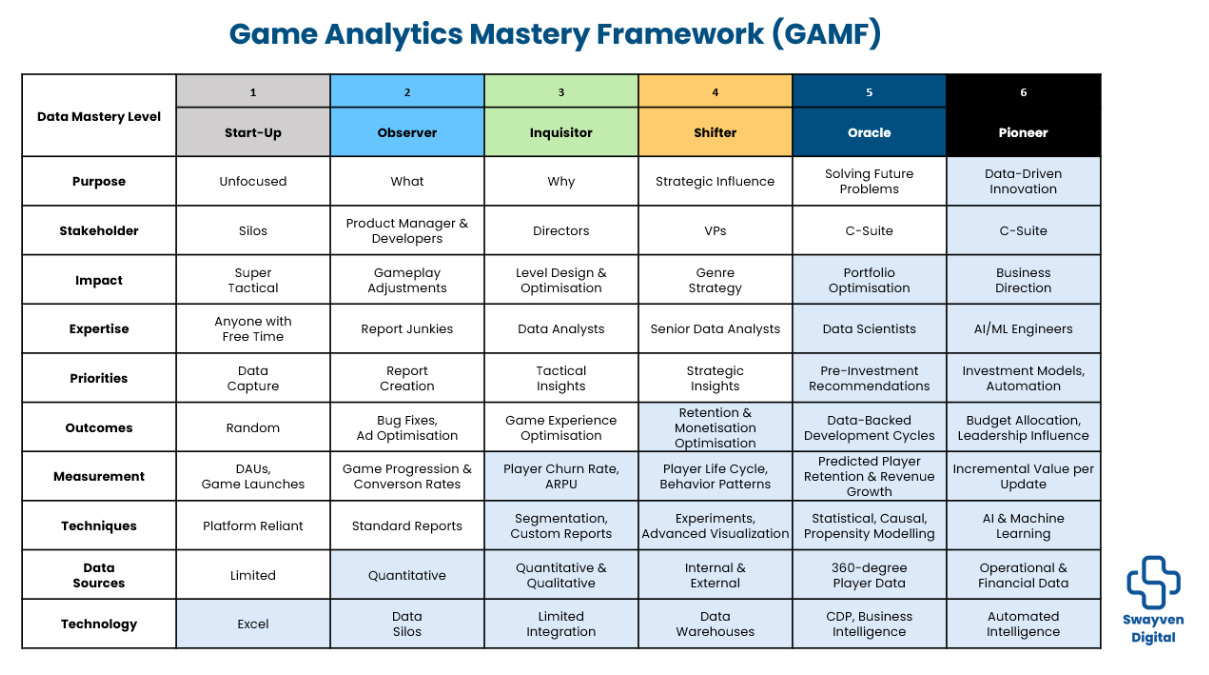In the dynamic world of game development and publishing, data-driven insights are paramount. Game studios, regardless of their size, have access to a plethora of tools and methodologies to collect, process, and analyse data. The Game Analytics Maturity Framework (GAMF) is a blueprint to help game companies navigate the vast data landscape and harness its potential for driving success in the competitive gaming market.
Common Challenges in Game Studios
- Data Silos – Fragmented and inconsistent data storage can prevent a unified view of game insights.
- Lack of Data Expertise – The absence of dedicated data professionals can hinder accurate data interpretation and insight extraction.
- Data Quality Issues – Some studios grapple with inconsistent data quality due to inadequate data validation processes.
- Inadequate Real-time Analytics – Limited capabilities for real-time data analysis hamper the studio’s ability to act and implement changes swiftly.
- Ineffective Optimisation – Without the right strategy, studios often struggle to optimise the games experience and monetisation.
Whether you’re an indie developer or a AAA game studio, the above patterns are prevalent. In 2023, it’s rare for a game studio to lack data. However, the real challenge lies in effectively utilising this data to achieve both short-term and long-term goals.
The gaming industry is unique, with its own set of challenges and opportunities. To truly leverage data, game studios need a framework that caters specifically to their needs. This GAMF model provides a roadmap for studios to assess their current capabilities and chart a course towards a higher level of data mastery.
The Game Analytics Mastery Framework (GAMF)
The GAMF identifies six stages of analytics maturity tailored for game studios:
1. Start-Up – The rudimentary phase with a lack of structured data strategy, primarily relying on sporadic tools and reports.
2. Observer – Centralised data reporting to understand WHAT trends and behaviours are emerging within the game.
3. Inquisitor – The ability to delve deep into the data to determine WHY certain game patterns and player behaviours are taking place.
4. Shifter – Overcoming data silos and focusing on overarching, holistic game and business growth plans.
5. Oracle – Leveraging advanced analytics techniques to solve future problems, such as game balancing, predicting player churn and forecasting game trends.
6. Pioneer – Utilising cutting-edge algorithms and technology to uncover hidden patterns in vast gameplay datasets.
In my experience, 25% of companies reach Level 4, less than 10% will be at Level 5 and a fraction of one percent are at Level 6 (this space is still kinda new so it’s expected I guess).
Analysing your position in the GAMF can be done by assessing the sophistication of your analytics practice using a series of 10 dimensions that give you in-depth insight into how your studio is currently data.

Assessing Your Analytics Mastery - Purpose & Stakeholders
To start understanding your studio’s data mastery level, consider your answers to these two questions:
- Purpose – “What purpose is served by a majority of our analytics investments in tools, teams, methodologies?”
- Stakeholders – “Who is our main audience to gain profound understanding from this data?”
Start-Up: The data is scattered, mostly leaning on whichever team member feels compelled to dig up and utilise some information.
Observer: The primary goal is to understand WHAT is happening within your game. These insights, when shared consistently, are mostly utilised by your game developers and designers.
Inquisitor: The main beneficiaries here are the game leads or project managers. The data’s role is to elucidate WHY specific in-game patterns are observed. You find yourself delving deep into the ‘why’, instead of just routinely distributing reports (which are mostly about ‘what’).
Shifter: A more refined focus: significant game development decisions often leading to alterations in game design or in-game marketing strategies. Basic reporting still has value at this stage, but it isn’t the dominant purpose of the analytics setup.
Oracle: A considerable chunk of your analytics resources (tools, teams, processes) are directed at addressing specific challenges like, “Players are dropping off after day 30, but we don’t know why!” Monthly briefings with the studio’s head or lead designer delve deep into performance metrics. It can be challenging being a game analyst at this stage, given the high stakes and potential scrutiny. Yet, the potential to reshape the game’s trajectory is enormous.
Pioneer: Here, the studio’s top brass, perhaps even the CEO, are your main audience. This level is exhilarating. The aim is to influence game-altering decisions. You’re at the forefront of game analytics tech. And your audience, equally data-driven, often wants to cut through the noise and says, “Let’s just follow what the metrics suggest.” The potential for influencing the game’s success is limitless, and you’re right at the heart of it, ready to bring about transformative changes.
Assessing Your Analytics Mastery - Impact
The next area for contemplation is Impact. To address this, consider your answer to this question:
“To what extent are our data-driven initiatives influencing game design, development and player experience decisions?”
Starting from Start-Up, which concerns super tactical choices, we advance to:
Observer – Immediate Gameplay Adjustments. (E.g., “Let’s tweak the loot drop rates.”)
Inquisitor – Level Design Optimisation. (E.g., “Here are recommendations to reduce difficulty spikes in this dungeon.”)
Shifter – Genre-Specific Strategy. (E.g., “How do we balance multiplayer mechanics versus single-player content?”)
Oracle – Studio Portfolio Decisions. (E.g., “Assessing the success probability of our next RPG versus a racing game.”)
Pioneer – Overall Game Studio Direction. (E.g., “How does our entire game lineup impact our brand’s positioning?”)
The above are just indicative questions, shedding light on the Game Impact Level of your studio’s analytics function.
Assessing Your Analytics Mastery - Expertise, Priorities & Influence
The ensuing three dimensions wield significant influence in predicting the role of data in enhancing game success. They are:
- Expertise – “What capabilities does our analytics team possess?”
- Priorities – “What tasks are they primarily focused on?
- Outcomes – “What is the end result of their work?”
For question 3, you may also want to double-check their alignment of how the work is requested and used within the business. For example, if your team claims to be analysing game monetization strategies, but their insights are only applied to tweak in-game tutorials, there’s a disconnect.
Let’s explore how expertise. priorities & influence is played at each mastery level:
Start-Up – Any team member working on data is likely doing so out of personal interest. Their main focus might just be on data collection and basic reporting.
Observer – Intentional efforts to employ data-savvy people to create meaningful reports to understand player behaviour. With their insights, gameplay mechanics might see subtle enhancements.
Inquisitor – With the help of a data analyst, the studio starts to realise the potential of advanced analytics. With more detailed analysis, data starts influencing broader game aspects, from storyline progression to character balancing.
Shifter – Introduction of Senior Game Data Analysts. Their role covers multifaceted game features – understanding player retention strategies, optimising in-game purchases, etc. Their influence permeates higher studio levels, including interactions with Studio Directors.
Oracle – The addition of Game Data Scientists to the team changes the game (pun intended). Instead of post-game release insights, data starts shaping games from their conception. These insights might dictate which game direction the studio should venture into next.
Pioneer – The pinnacle, sees data insights guiding the studio’s overarching direction, with consistent interactions with the studio’s C-Suite. At this stage, your analytics function is likely playing a crucial role in helping the development & marketing teams with their unbreakable budget pitches to the CFO. Advanced data engineering and automation play crucial roles here, setting the stage for future game innovations.
Operating at the Oracle & Pioneer levels is the epitome of game analytics. The work might be intensely scrutinised and challenging, pushing you beyond your known boundaries. However, the role of data at these levels profoundly transforms the studio, paving the path for monumental success.
Assessing Your Analytics Mastery - Measurement & Techniques
To understand this area of your data mastery, consider your answer to these questions:
- Measurement – “How sophisticated are the KPIs that the game development team (from frontline developers to studio executives) is using?”
- Techniques – “What analysis techniques support the major decisions recommended by data?”
In game development, I’d say there are 7 categories of KPIs:
- Acquisition – (Installs, Ad Impressions, Cost per Install, etc)
- Activation – (First-Time Launches, Onboard Completions, etc)
- Engagement – (Sessions, Avg Duration, Social Shares, etc)
- Gameplay – (# of in-game events, Win-Loss %, Mission Completions, etc)
- Retention – (DAUs, MAUs, Stickiness, etc)
- Technical – (Errors, Crashes, Uptime, etc)
- Monetisation – (Ad Revenue, In-Game Revenue, LTV, etc)
KPI = A key performance indicator is a metric that helps you gauge how you’re progressing towards game development and business objectives.
Let’s delve deeper into how measurement & techniques are utilised at each mastery level:
Start-Up – The scope is narrow, perhaps focusing on daily bugs or simple in-game metrics. The KPIs might look at things like Daily Active Users or simple metrics like Level Completions. At this stage, you’re likely using out-of-the-box analytics tools provided by game engines or advertising platforms.
Observer – Now, your scope expands further reflecting deeper insights into game progression and player behaviour. KPIs could include Player Retention Rates and Conversion Rates from free to paid users. Standard reports give consistent insights that can affect game updates or patches.
Inquisitor – This is where the “real” analysis starts to happen. KPIs like Player Churn Rate and Average Revenue Per User offer deep insights into game performance. With custom reports and segmented data, decisions about in-game purchases, advertisements, and game design become more informed.
Shifter – Your analytics team is starting to cause ripples throughout the business. They’re advising on major game design choices, from character development to in-game economies. Complex data concepts like Player Life Cycle or In-game Purchase Patterns, provide a holistic view of your game’s health. Regular A/B testing for game features ensures optimal player experiences. Advanced data visualisation techniques illustrate the game’s progress beautifully.
Oracle – At this stage, you’re not just looking at past data but predicting future player behaviours. KPIs such as Predicted Player Retention and Predicted Revenue Growth become crucial. Machine Learning helps in forecasting potential game updates’ outcomes. If your Game Director values data-driven decisions, it’s because your analytics team has propelled the studio to this stage.
Pioneer – A few elite studios achieve this. Meetings with the studio heads are frequent since analytics can demonstrate the Incremental Value and Cost of each game update or feature. Your analytics system is so advanced that it predicts future game trends. Every game development decision is backed by robust data.
If you’re part of a pioneer game analytics team, consider asking for a significant raise! Your analytics mastery is undeniably a driving force behind the studio’s success.
Assessing Your Analytics Mastery - Data Sources & Technology
No game studio can reach the Oracle stage can gain the capability to predict Player Lifetime Value (pLTV) for every gamer interacting with their title, without having the proper assembly of game data in a robust infrastructure.
The final two questions to contemplate in your analytics mastery journey are:
- “Which game-related data does our Analytics team have access to derive actionable insights for enhancing the player experience?
- “What kind of technological backbone has our engineering team crafted to bolster game analytics, player intelligence, and in-game automation?
Here’s some detailed guidance for gauging where you currently stand. Always evaluate the weakest point…
Start-Up – The data you access is confined to the basics—whatever your game analytics tool provides (like Unity Analytics) or, if not that, any metrics an ad platform offers (like Unity Ads Dashboard). The most prevalent way to disseminate this data? The trusty Excel or Google Sheets.
Observer – You’ve integrated a combination of analytics tools, ensuring comprehensive tracking across your game’s UI and gameplay activity. By Level 2, data is trapped in diverse silos. For instance, you might struggle to reconcile in-game purchases in your analytics tool with the actual revenue in your monetisation system. It’s a start, with reports generally highlighting WHAT actions players take, game progress, and conversions.
Inquisitor – Your analytics team starts to utilise not only quantitative data, but also qualitative ones such as player feedback, forums, and social media reviews. After regular analysis, you’ve initiated some integration, making your insights much richer in explaining player behaviour and sentiment.
Shifter – Major game design decisions, impacting budget allocation for sequels or DLCs, are informed by integrated data warehouses. These warehouses combine your in-game analytics, advertising data, and even external sources like gaming forums and third-party reviews.
Oracle – Predictive game analytics becomes your focus. This is powered by an advanced CDP and/or BI platform, consolidating years of well-structured player data. While attracting new players is great, true sustained success hinges on retaining and understanding existing players to anticipate their future in-game actions and spending patterns.
Pioneer – The final data piece? Your operational/financial metrics, merged with game analytics, player interactions, and feedback loops. Now, your infrastructure is not just about aggregating data but also about deploying automation for in-game actions and monetisation. For instance, if certain in-game items underperform or excel, automating pricing adjustments or promotions becomes the game-changer, minimising manual interventions.
While Data Streams and Infrastructure are the concluding points in this Game Studio Maturity Model, they’re foundational. Their placement at the end is only to emphasise a trap: many studios over-focus on just gathering heaps of data and generating endless reports. That’s a Level 1 or 2 approach, whereas true advancement requires strategic integration and utilisation of this data.
Closing Thoughts
In the ever-evolving realm of game development, the importance of data-driven decision-making cannot be overstated. As we’ve explored, the Game Analytics Maturity Framework (GAMF) offers a comprehensive guide for studios to evaluate and elevate their analytics prowess. From addressing common challenges like data silos and quality issues to understanding the intricacies of analytics mastery across various dimensions, the GAMF provides a structured approach tailored for the gaming industry.
However, it’s crucial to remember that data alone isn’t the magic wand. It’s the strategic application of these insights, combined with a studio’s creativity and innovation, that truly propels a game to success. Whether you’re at the Start-Up phase or pioneering new frontiers in game analytics, the journey is continuous. Embrace the GAMF not just as a roadmap but as a compass, guiding your studio towards informed decisions, enhanced player experiences, and ultimately, unparalleled success in the gaming world. As the gaming landscape continues to shift, those studios that master the art and science of analytics will undoubtedly lead the pack, setting new benchmarks and crafting unforgettable gaming experiences for players worldwide.
Disclaimer: The GAMF is inspired from Avinash’s Modern Analytics Maturity Model (MAMM).
Thank you for taking the time to read our article. At Swayven Digital, we help game studios & publishers boost their profitability by refining their analytics & optimisation strategies. If you’d like to learn more about our services and how we could assist you, please don’t hesitate to get in touch with us.
Stay tuned for more insights, and until next time, keep optimising!




